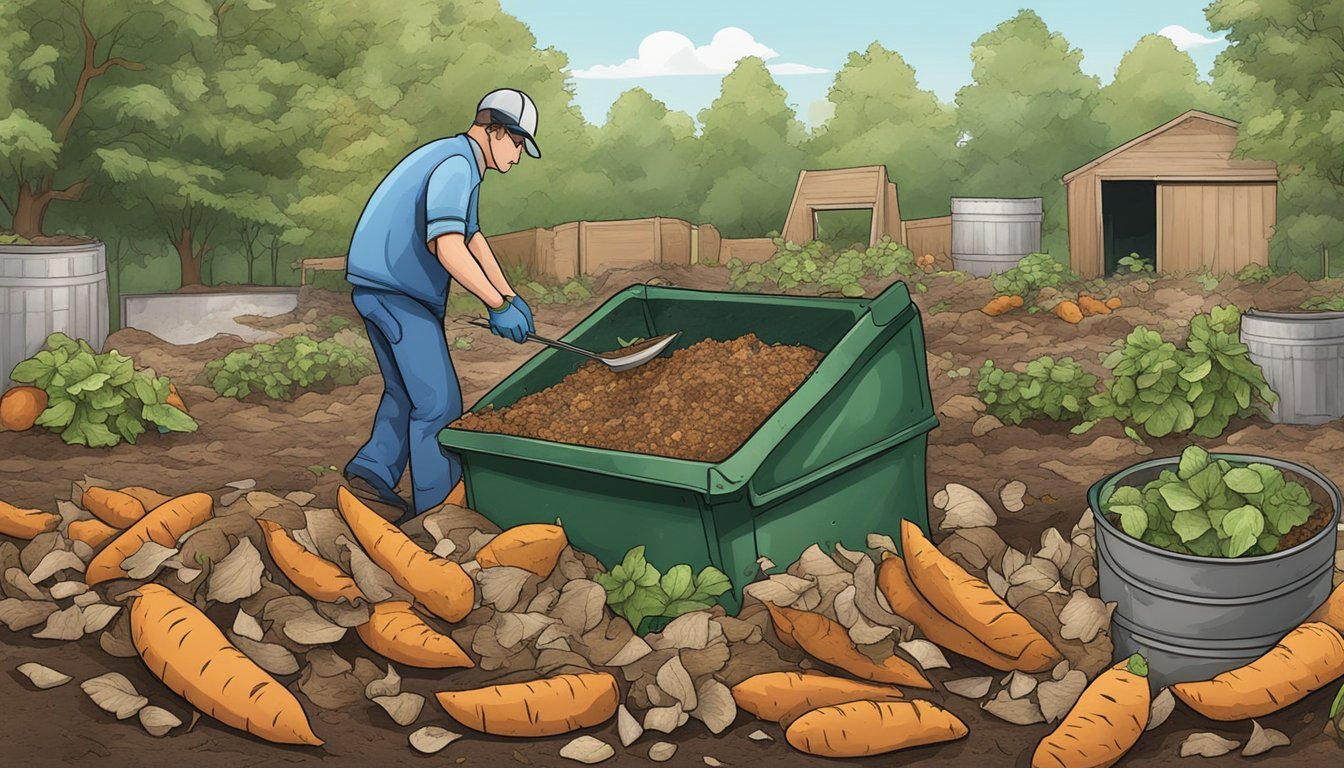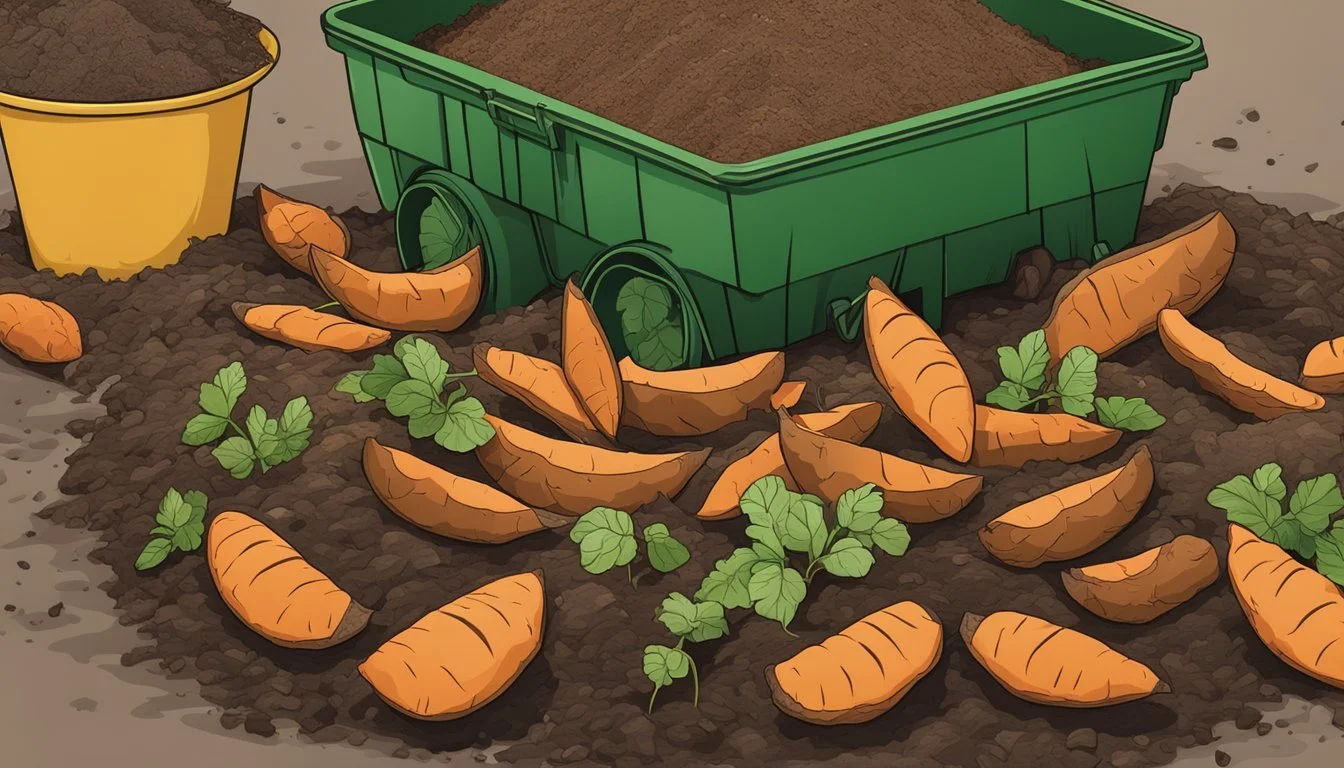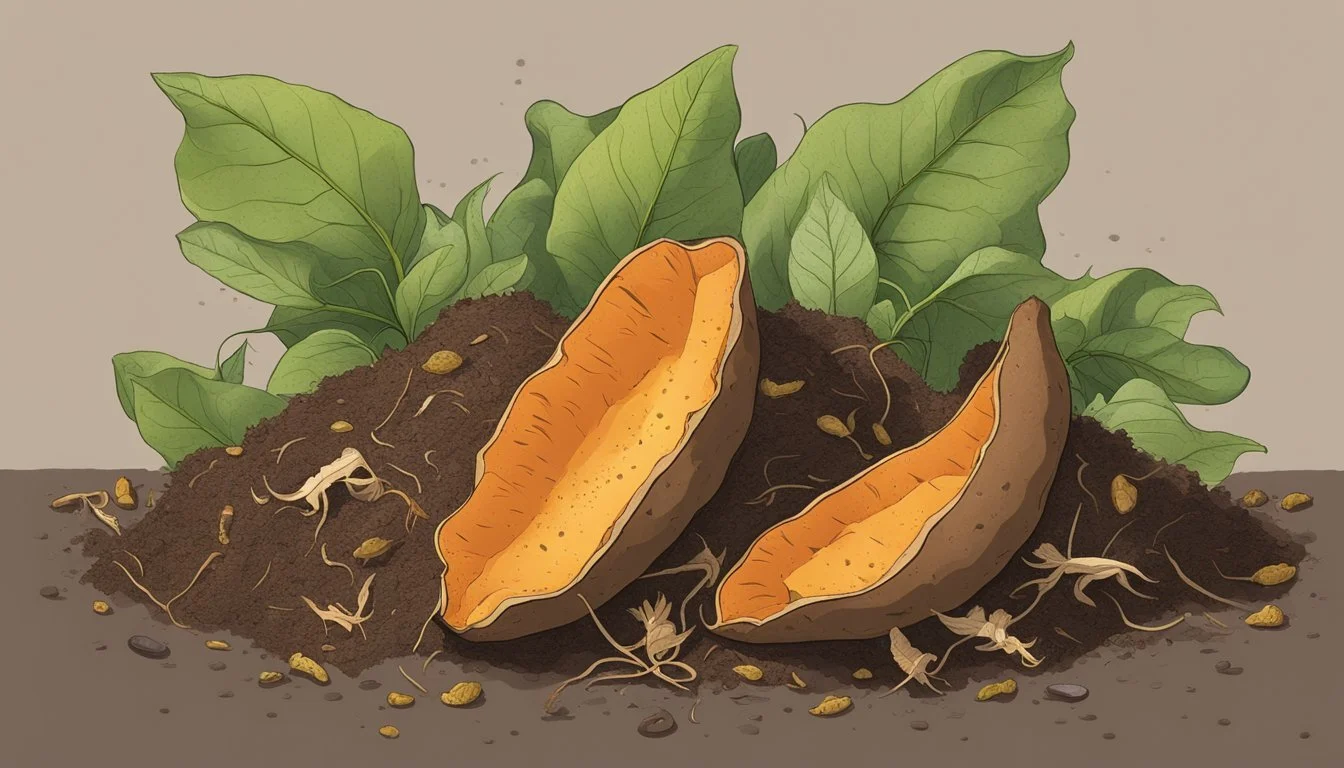Can You Compost Sweet Potato Skins?
Understanding Biodegradable Waste Management
Composting sweet potato skins is a beneficial practice for both gardeners and environmentally conscious individuals. The process of composting these scraps, along with other organic kitchen waste, provides a rich source of nutrients for garden soil, contributing to soil health and plant growth. Sweet potato skins break down readily in a compost pile and can be incorporated just as one would with other vegetable peels and scraps.
In home composting systems, sweet potato peels add valuable nitrogen, an essential element that helps to create a balanced compost. While concerns exist regarding the composting of certain types of vegetable peels due to the presence of pathogens, proper composting techniques can mitigate these issues. As with any composting endeavor, ensuring a mix of 'greens' and 'browns'— that is, nitrogen-rich and carbon-rich materials — and maintaining appropriate moisture and aeration are key to successful decomposition and nutrient cycling.
For those without access to an outdoor composting area, vermicomposting offers an indoor alternative that also accommodates sweet potato skins. By using specific species of worms in contained systems, individuals can break down their kitchen waste, including sweet potato peels, into vermicompost—an extremely nutrient-rich byproduct that benefits houseplants and gardens alike.
Basics of Composting
Composting is the natural process of recycling organic matter, such as leaves and vegetable scraps, into a valuable fertilizer that can enrich soil and plants.
Understanding Compost
Compost is produced when organic materials break down into simpler forms of matter. This transformation occurs through the action of microorganisms, such as bacteria and fungi, in the presence of air (oxygen) and moisture. The decomposition process generates heat, which helps to sanitize the compost by eliminating pathogens and seeds.
Components of a Compost Pile
A well-balanced compost pile requires a mix of greens and browns. Greens are materials rich in nitrogen, such as vegetable scraps and coffee grounds, which provide the microorganisms with energy. Browns are carbon-rich materials, including dry leaves, twigs, and paper, giving the microorganisms the structure necessary to aerate the pile.
Greens (Nitrogen-rich)
Vegetable waste
Fruit scraps
Grass clippings
Browns (Carbon-rich)
Dry leaves
Twigs
Cardboard
The right balance between greens and browns (typically a ratio of 1 part greens to 3 parts browns) is crucial for maintaining the appropriate levels of moisture and air circulation within the pile. This balance supports the efficient breakdown of organic matter into compost.
Benefits of Composting Sweet Potato Skins
Composting sweet potato skins is a practical method for enriching soil with essential nutrients and significantly reducing kitchen waste. Through composting, these peels contribute to a nutrient-rich amendment for garden soils.
Nutrient Content in Sweet Potato Skins
Sweet potato skins are a valuable source of minerals such as potassium, phosphorus, and magnesium. These nutrients play a crucial role in plant growth, with potassium aiding in water regulation, phosphorus contributing to root development, and magnesium being a central component of chlorophyll. Additionally, sweet potato peels contain notable amounts of calcium as well as a variety of vitamins, further bolstering their contribution to a balanced compost that can enhance soil fertility.
Potassium: Essential for water balance and metabolic processes.
Phosphorus: Supports development of roots and blooms.
Magnesium: Key for photosynthesis and enzyme function.
Calcium: Vital for cell wall structure and stability.
Vitamins: Contribute to overall plant health.
Reducing Waste with Composting
Incorporating sweet potato skins into compost helps in reducing kitchen and food waste. Instead of discarding these nutrient-rich scraps into landfills where they contribute to methane emission, one can compost them to create an organic, nutrient-enriched soil amendment. By doing so, they convert what would be waste into a beneficial resource that improves soil structure and enhances the growth of various plants.
Reduction in landfill waste: Less methane emission, a potent greenhouse gas.
Value from scraps: Transforms kitchen leftovers into valuable compost.
The combination of sweet potato peels' rich nutrient profile and the advantage of minimizing food waste underscores the important role composting plays in sustainable gardening practices. By adding these skins to compost, individuals enhance not only the health of their gardens but also contribute to a more environmentally friendly approach to waste management.
Proper Techniques for Composting
Composting sweet potato skins successfully necessitates a balance of green and brown materials, appropriate environmental conditions, and periodic turning. These actions facilitate microbial activity and accelerate the decomposition process.
Layering Greens and Browns
A compost pile should be thought of in layers, alternating between nitrogen-rich green materials and carbon-rich brown materials. Sweet potato skins fall into the 'green' category and should be balanced with 'brown' materials like dry leaves, twigs, or shredded paper to create an optimal environment for decomposition.
Green Materials (Nitrogen)
Sweet potato skins
Fruit scraps
Vegetable scraps
Brown Materials (Carbon)
Dry leaves
Twigs
Cardboard
Maintaining the Correct Conditions
The compost pile requires the right conditions to encourage decomposers to thrive. The pile should be kept moist, but not overly saturated. Temperature is also crucial, as a warm pile accelerates decomposition. These conditions foster the growth of bacteria and fungi critical for breaking down organic matter.
Moisture: Should feel like a wrung-out sponge
Temperature: Ideally between 140°F and 160°F
Turning the Compost Pile
Regularly turning the compost pile introduces oxygen, which is necessary for aerobic decomposition and helps maintain consistent temperature and moisture throughout. This aeration prevents material from becoming compacted and smelly, and it enhances microbial activity, thus reducing the time needed to produce finished compost.
Frequency: Every few weeks or when the center of the pile cools down
Tools: Pitchfork or compost turner
Potential Challenges and Solutions
When composting sweet potato skins, it's crucial to consider the risks of disease and pest attraction. Properly managing these challenges ensures the composting process is effective and beneficial for garden soil.
Dealing with Potato Diseases
Sweet potato skins can carry diseases such as potato blight, which is caused by a fungus-like organism. This disease spreads via spores that can survive in compost and affect subsequent plantings. Here are specific strategies to handle these issues:
Precautions: Always inspect potato peelings for signs of disease before adding them to the compost pile. If the skins are from potatoes (What wine goes well with potatoes?) that showed any sign of blight or other fungal diseases, it's safer to exclude them.
Soil Health: Maintain a healthy compost pile by turning it regularly to ensure that it reaches high temperatures, which can kill off fungal spores that cause potato diseases.
Managing Pest Attraction
Sweet potato peelings, if not managed properly, can attract pests to the compost pile. To minimize this problem, one should adopt the following practices:
Burying Peelings: Bury sweet potato skins deep within the compost pile to reduce their accessibility and attraction to pests.
Balanced Composition: Ensure the compost has a balanced mix of green and brown materials to prevent creating an environment that pests find appealing.
Enclosures: Use a compost bin with a lid or a securely enclosed space to discourage animals and pests from invading the compost in search of food.
Composting Sweet Potato Skins Safely
Composting sweet potato skins is a simple and eco-friendly process if one adheres to certain safety measures which prevent sprouting and contamination.
Avoiding Growth and Contamination
Sprouting: Sweet potato skins can easily sprout and start growing new plants. To inhibit sprouting, gardeners should:
Chop skins into small pieces before adding them to the compost.
Maintain a balanced compost by burying the skins under other materials, which also helps to avoid attracting pests.
Contamination: Sweet potato skins should be composted properly to prevent any chance of disease. If skins are from plants that were diseased, they should not be added to the compost because they can spread pathogens.
Best Practices for Disease Prevention
Safe Handling: When composting sweet potato skins, one must ensure that no diseased material is introduced. Composting diseased plants can lead to a spread of pathogens like solanine that can persist in the compost and harm future plants.
Vermicomposting: Utilizing worms for composting (vermicomposting) is a method that can turn sweet potato skins into nutrient-rich fertilizer without the risk of rotting or fostering diseases. Microorganisms in the worm's digestive systems break down organic matter effectively, minimizing disease risks.
In vermicomposting setups:
A balanced ratio of browns (carbon-rich materials) and greens (nitrogen-rich materials) is essential.
The moisture level should be around 75% to create an ideal environment for worms and beneficial microbes.
Advanced Composting Techniques
When composting sweet potato skins, employing advanced techniques such as vermicomposting and temperature-controlled composting can optimize the decomposition process and nutrient recycling.
Vermicomposting with Worms
Vermicomposting harnesses the natural digestion process of worms to break down organic matter like sweet potato skins. Worm bins or specially designed containers create an ideal habitat for worms, consisting of shredded paper and a moisture level around 75%. As the worms consume the scraps, they produce vermicast, a nutrient-rich byproduct, which is excellent for plant growth.
Setup: A worm bin can be indoor or outdoor, provided the temperature is kept consistent for the worms' comfort.
Maintenance: Regular monitoring is required to ensure the environment is not too wet or dry, and to add more shredded paper as bedding when needed.
Hot and Cold Composting
Temperature is a critical factor in hot and cold composting methods. Both techniques can accommodate sweet potato skins but under different conditions.
Hot Composting:
Temperature Range: Maintains between 120°F to 160°F.
Process: Accelerated decomposition with frequent turning to aerate, ensuring an even breakdown of materials including sweet potato skins.
Time Frame: Completion can be as quick as a few weeks with the right balance of materials.
Cold Composting:
Temperature Range: Usually under 120°F.
Process: Slower decomposition, requiring less maintenance but taking months to a year for materials to fully break down.
Time Frame: A passive approach, making it more suitable for gardeners who prefer less frequent compost management.
In both hot and cold composting, a balance of 'green' (nitrogen-rich) and 'brown' (carbon-rich) materials is essential for effective nutrient cycling and to prevent odor and pests. Sweet potato skins are considered 'green' material.
Composting as Soil Fertilizer
Compost derived from kitchen scraps, such as sweet potato skins, offers a wealth of nutrients to enrich soil. The process transforms waste into a valuable resource that enhances soil health and fertility.
Improving Soil Health with Compost
Composting turns organic waste materials into a nutrient-rich product that acts as a natural fertilizer for soil. When sweet potato skins and other compostable materials break down, they contribute to a complex ecosystem within the soil. The inclusion of compost improves soil structure, enabling it to retain moisture more effectively and providing a better environment for root growth.
One of the key benefits of using compost as a soil amendment is the addition of essential nutrients that plants require for growth. Sweet potato skins, specifically, decompose to contribute nitrogen, phosphorus, potassium, and magnesium—all vital elements for plant nutrition.
Nitrogen is critical for leaf growth.
Phosphorus supports the development of roots and flowers.
Potassium helps with overall plant health.
Magnesium is a central component of chlorophyll.
Moreover, composting acts as a soil conditioner, introducing beneficial microbes that aid in breaking down organic matter, thus releasing nutrients more effectively. This provides a slow-releasing, fertilizer effect, which reduces the need for chemical alternatives.
As compost breaks down, it enhances soil's ability to support a healthy ecosystem for garden and crop plants. The addition of compost to soil not only recycles kitchen waste like sweet potato skins but also supports sustainable gardening practices by improving soil health and reducing waste.
Items to Avoid in the Compost Pile
When composting, it's crucial to be aware of what should not be included in the compost pile to maintain a healthy decomposition process.
Non-Compostable Materials
Diseased Plants: Including sweet potato skins or any plant material that shows signs of disease can introduce pathogens into the compost, potentially harming future plant growth.
Weeds: Certain weeds may survive the composting process and spread when the compost is used, leading to an unwanted infestation.
Dairy Products: Avoid composting milk, cheese, butter, and other dairy products as they can create odor problems and attract pests.
Fats and Oils: This includes substances like olive oil, which can disrupt the balance of the compost pile and slow down the decomposition process.
It’s essential to exclude these items to ensure that your compost pile remains a beneficial resource for garden soil enrichment.
Tips for Using Composted Material
Successfully composted sweet potato skins can be transformed into nutrient-rich compost, enhancing soil fertility and structure. This section covers practical ways to utilize the composted material in gardening efforts.
In the Garden
In the garden, composted material can serve as a valuable amendment for soil. It introduces essential nutrients and improves soil aeration, which supports root growth and plant health. Gardeners can incorporate this nutrient-rich compost into the planting beds by:
Mixing it thoroughly with the top layers of soil prior to planting.
Using it as a side dressing for established plants to slowly release nutrients.
As Mulch or Topsoil
Composted material also works effectively as a mulch or a top layer on garden beds. This application helps to retain moisture in the soil, suppress weeds, and over time, further enrich the soil's nutrient content. Here's how to use composted material as mulch or topsoil:
Applying a 2–3 inch layer around plants, taking care not to mound against the stems to avoid rot.
Spreading an even layer across garden beds in the fall to protect and nourish the soil over winter.
Environmental Impact and Sustainability
Composting sweet potato skins is a significant step toward sustainability. Organic waste, such as food scraps including sweet potato skins, can be repurposed into nutrient-rich compost rather than contributing to landfill mass. In landfills, this organic material releases methane, a potent greenhouse gas. By composting, methane emissions are significantly reduced, thus lessening the environmental impact.
The practice of composting also plays a role in soil quality improvement. When sweet potato peels become compost, they return valuable nutrients to the soil, enhancing its fertility and structure. This supports healthier plant growth and conserves soil ecosystems, feeding into the cycle of sustainability.
The composting process itself must be managed to mitigate potential negative effects on the environment. For instance:
Reduction of Ammonia Emissions: Proper compost maintenance can minimize the conversion of nitrogen into ammonia, which, if released into the atmosphere, can cause air pollution.
Consideration Benefit Concern Greenhouse Gases Reducing methane emissions from landfills N/A Soil Health Restores valuable nutrients to the soil N/A Ammonia Production Can be controlled with proper techniques If mismanaged, can lead to air pollution
In summary, composting sweet potato skins is a sustainable choice that reduces organic waste, decreases greenhouse gases, and replenishes soil — fortifying a commitment to ecological balance.








